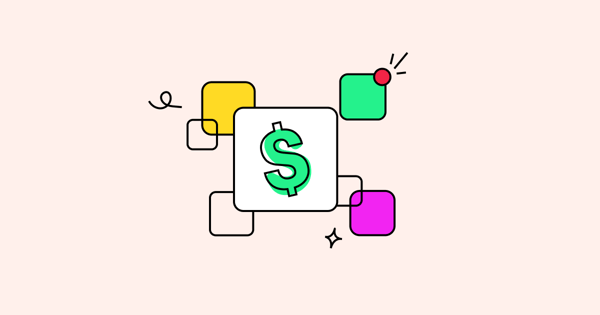Pricing your ecommerce products might sound like an easy feat.
Just set a price, and away you go.
In reality, it can be challenging, and it's one of the most important things to do right.
Poor pricing can lead to missed opportunities for new conversions and customer engagement, while smart pricing strategies can boost profits and foster customer loyalty.
That's why we've come up with this article - to provide you with some real examples of successful ecommerce pricing strategies. For every section, we will explain to you what the pricing strategy is and show real examples of how it works.
So, if you're ready to learn more about effective ecommerce pricing strategies, let's get started.
Let's look at each example in more detail.
1. Blendjet - Psychological Pricing
Psychological pricing focuses on playing with the customer's perception of value.
The most commonly used ones are in grocery stores (pricing the product at $9.99 or $9.95 instead of $10).
Most ecommerce stores use this simply because it works well and is easy to execute.
A brand selling portable blenders, Blendjet uses the exact same pricing strategy to its advantage.
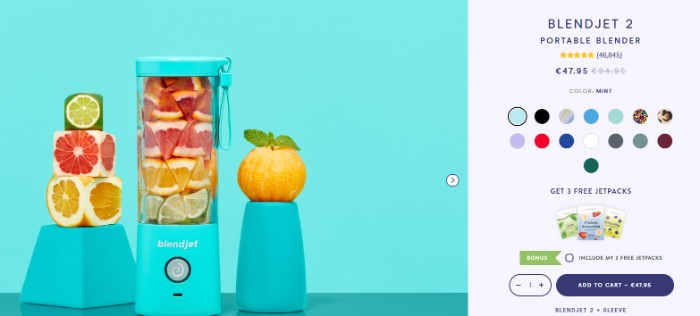 For all of their products, they're using prices like $47.95.
For all of their products, they're using prices like $47.95.
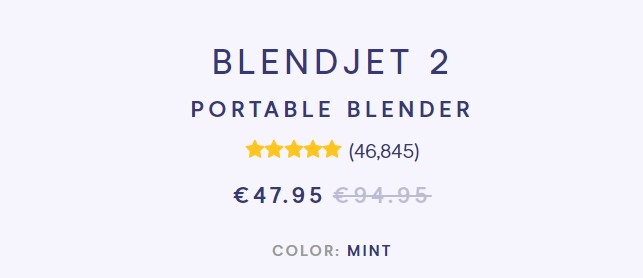 The same strategy is also applied to their discount prices. There are no secrets to what they do. It’s simple, and that’s why it works.
The same strategy is also applied to their discount prices. There are no secrets to what they do. It’s simple, and that’s why it works.
While this works for Blendjet, it's not the right way for all brands.
If the customer bases the purchase decision more on logic, more specific numbers like $624.74 or $1,453.32 can work much better.
See how Dell is pricing its products:
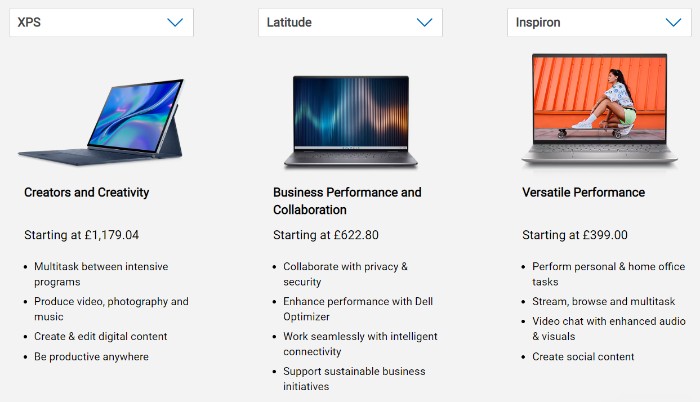 For the customer, it feels like Dell is calculating the individual pieces inside the computer and setting the price based on those. Ultra-specific prices like these work especially well for brands in the tech, electronic, or automotive industries.
For the customer, it feels like Dell is calculating the individual pieces inside the computer and setting the price based on those. Ultra-specific prices like these work especially well for brands in the tech, electronic, or automotive industries.
On the other side, many brands use round numbers in their pricing, especially in niches like clothing, personal care, or jewelry.
Chubbies is doing this with its prices, making them round and simple, with no syllables.
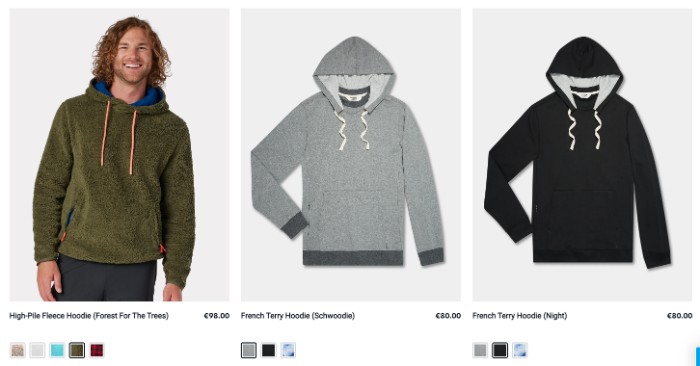 This works for them; I'm sure they've A/B tested what works best, and that's ultimately what you should do with your prices.
This works for them; I'm sure they've A/B tested what works best, and that's ultimately what you should do with your prices.
2. Tiege - Decoy Effect
The decoy effect refers to a pricing strategy that involves adding a third option to help increase the likelihood of customers choosing a specific option.
A real-life example of this is from the cinemas when buying popcorn.
Let's say there are only two popcorn options available, Small = $4.00 and Big = $7.00.
In most cases, the customer would pick the cheaper one, as the larger one feels too expensive.
When we come up with a third option, things usually change.
Small = $4.00, Medium = $6.50, and Big = $7.00.
Now as there is the middle option, the decoy, customers will suddenly decide to go with the bigger one, as it's now more appealing.
In the same way, you can use the decoy effect when pricing your products for an ecommerce store, and Tiege is showing a solid example of that.
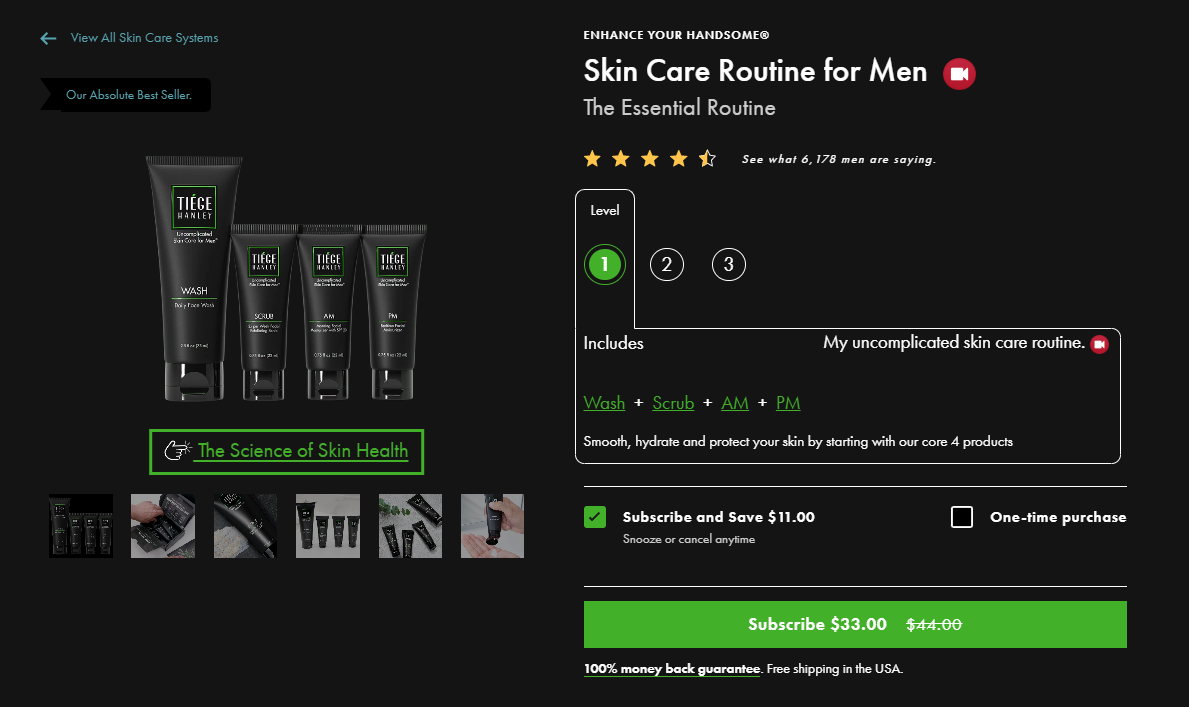 Tiege shows three levels of skincare routines for their customers. The higher the level, the more value they add and the higher the price.
Tiege shows three levels of skincare routines for their customers. The higher the level, the more value they add and the higher the price.
They want to make sure that the customer doesn’t pick a Level 1 skincare routine, which is their cheapest option. They do this with small things, like the discount, which is higher on the Level 2 and Level 3 plans.
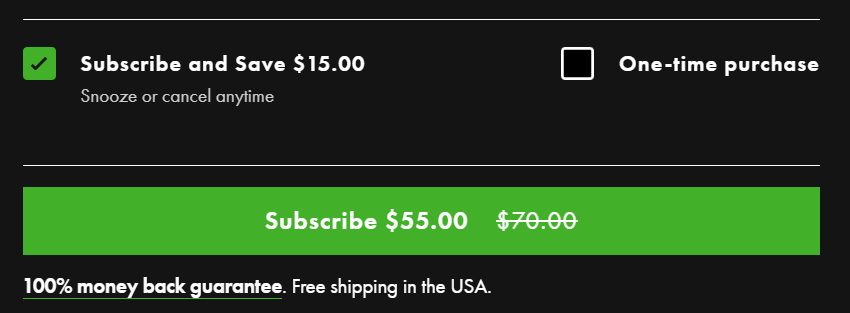 They’re also doing a good job of visually showing the value that you get if you select the Level 2 or Level 3 plan. They visually show you that you get one extra product by selecting the Level 2 plan, which also has the benefit of “fighting off crow’s feet and dark circles.”
They’re also doing a good job of visually showing the value that you get if you select the Level 2 or Level 3 plan. They visually show you that you get one extra product by selecting the Level 2 plan, which also has the benefit of “fighting off crow’s feet and dark circles.”
 And if you select the Level 3 plan, you get two extra products and the benefit of “reducing fine lines and achieving maximum handsomeness.”
And if you select the Level 3 plan, you get two extra products and the benefit of “reducing fine lines and achieving maximum handsomeness.”
 Isn’t that enough to convince you to select either the Level 2 or Level 3 plan?
Isn’t that enough to convince you to select either the Level 2 or Level 3 plan?
It simply feels like you lose too much with the cheapest plan, and for that reason, you either opt for the most expensive or middle-tier plan, which is what you want to achieve with the decoy effect.
Sometimes, decoy pricing doesn't always go as expected. We recently spoke with John Roman of Battlbox, who opened up about how their pricing tiers have changed over the years. John thought that the Pro Plus plan would be the decoy and that most customers would go for Pro, but it turned out that most customers saw the value of of the Pro Plus box and felt their pricing reflected that value.
3. Karma And Luck - Premium Pricing
Premium pricing is a strategy that involves setting prices that are higher than the average market price. The idea is to position the product as something special and luxurious, making it worth the extra money.
The product itself doesn't necessarily have to be better.
It's just perceived that way.
A saying by Simon Sinek relates to why premium pricing can work so well: "People don't buy what you do; they buy why you do it."
Brands like Apple and Rolex are great at this. People are willing to pay a premium price for these products because they feel like they are buying more than a product; they are buying a lifestyle.
Because both brands are so enormous, I wanted to show an example of a smaller brand using the same pricing strategy.
Karma and Luck provide a good example of premium pricing with all of their products. They're an ecommerce brand mostly selling crystal trees and wearables.
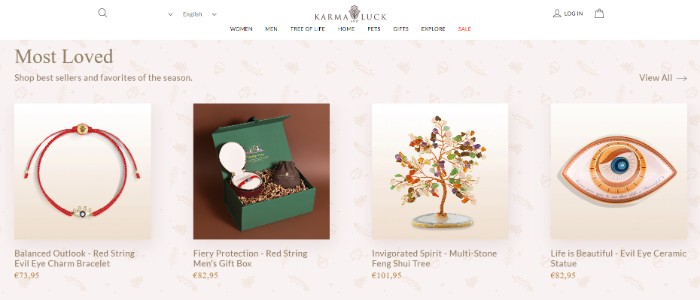 When compared to their competitors, Karma and Luck's prices can be as much as five times higher.
When compared to their competitors, Karma and Luck's prices can be as much as five times higher.
How can they get away with that?
They've purposefully built this premium look and feel, making the product appear luxurious and worth the extra money. Everything on their website screams this, from their copywriting style to color choices to high-quality images and typography.
They follow their brand voice through every touchpoint - and that's why they can justify their premium pricing.
Even the names of the products give the feeling that the customer is buying more than just a product:
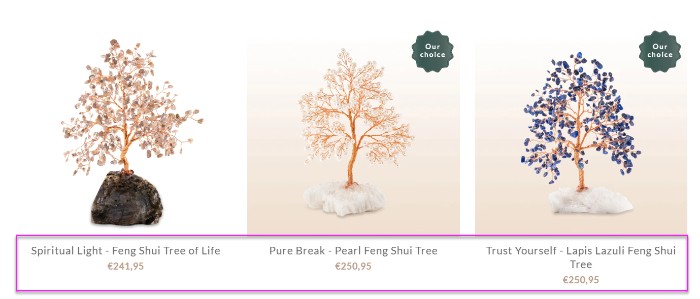 The product names Spiritual Light, Pure Break, and Trust Yourself” match their brand tone and the luxurious feeling extremely well.
The product names Spiritual Light, Pure Break, and Trust Yourself” match their brand tone and the luxurious feeling extremely well.
They are doing a good job of selling you their lifestyle of peace and balance through their products. People who appreciate these things will buy from them.
And for that reason, customers are drawn to them over their competitors, who might be selling the same products for a much more affordable price.
That's how premium pricing works.
4. Prose - Value-Based Pricing
A bit related to premium pricing, value-based pricing is a strategy that focuses on setting prices based on the product's perceived value. The idea is to ensure that customers pay what they think something is worth instead of just the cost price.
For example, if your product solves a massive problem, it is perceived as a higher-value item, and thus you can price it accordingly.
A good example of this is Prose, a company that sells fully customizable hair-care products.
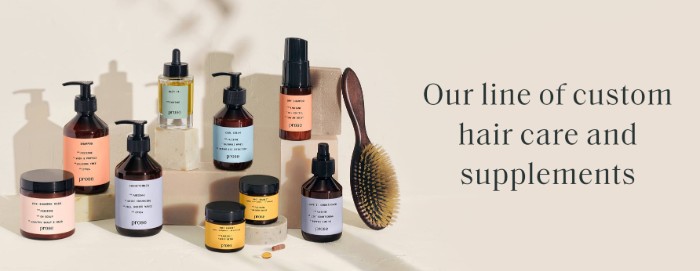 They offer tailor-made hair care products based on the customer's hair type. That's a huge value-add compared to generic hair care products, which gives Prose the ability to price their products based on the value they offer.
They offer tailor-made hair care products based on the customer's hair type. That's a huge value-add compared to generic hair care products, which gives Prose the ability to price their products based on the value they offer.
When looking at Prose's prices, they're still quite affordable:
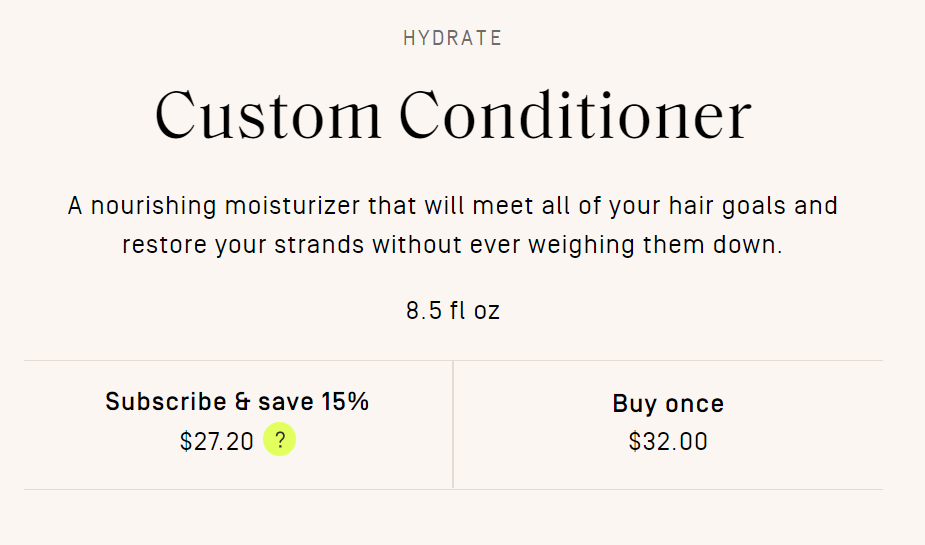 But because Prose's products have such a high value attached to them (they solve a big problem), they can be much more flexible with their pricing and still get away with it.
But because Prose's products have such a high value attached to them (they solve a big problem), they can be much more flexible with their pricing and still get away with it.
If you can identify your product's value and communicate that to customers, you can use value-based pricing to your advantage.
5. Harry's - Bundle Pricing
Bundling involves combining two or more products and selling them at a discounted rate compared to buying them separately.
That is not the only example of product bundling. There are other ways, like bundling complementary products, offering "buy one, get one free" bundles, and offering subscription-based bundles.
We've shown Harry's ecommerce store multiple times on the Drip blog, and we're showing it again due to their great subscription-based bundles.
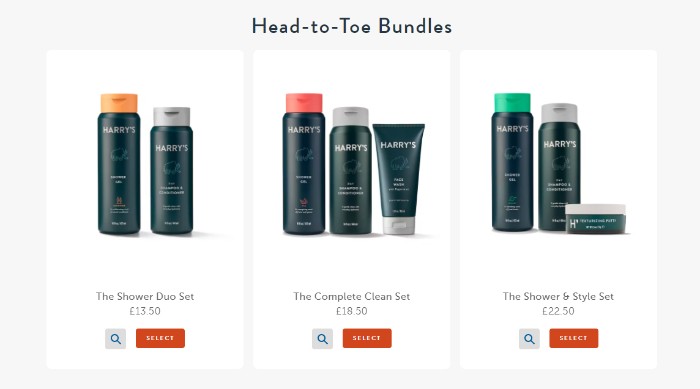 Their bundle pricing works so well because they're good at demonstrating how the products in the bundle complement each other.
Their bundle pricing works so well because they're good at demonstrating how the products in the bundle complement each other.
On its product page, Harry’s describes the Skincare Essentials Set as a single product that contains "three must-haves" rather than a random collection of three products.
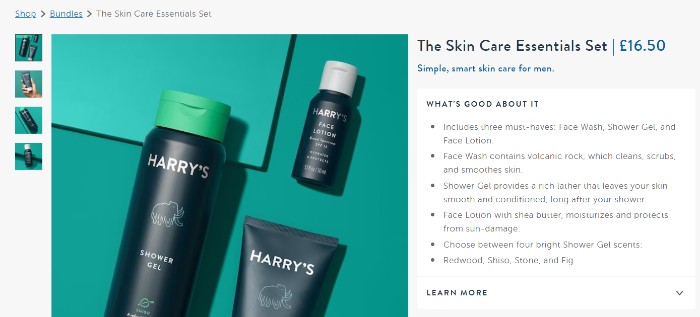 If you were to sell bizarre combinations like a razor, shampoo, and socks together, it could become challenging to explain why someone should buy the bundle.
If you were to sell bizarre combinations like a razor, shampoo, and socks together, it could become challenging to explain why someone should buy the bundle.
Another fantastic example of bundle pricing comes from Murad. They have created a skincare quiz that customers can go through to find the perfect combination of products for their skin type.
Once you've answered the seven questions, Murad shows you the products they think are the best fit for you.
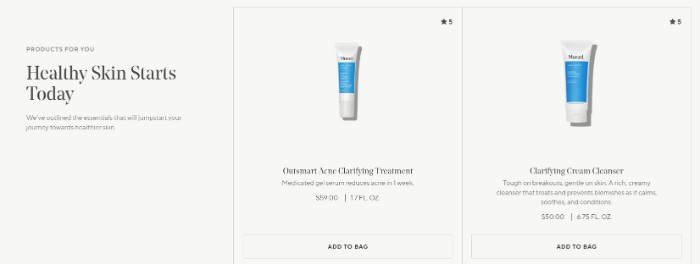 They don't even lower the prices. Just by bundling the products with the quiz, they can sell them as an attractive package, and customers love it.
They don't even lower the prices. Just by bundling the products with the quiz, they can sell them as an attractive package, and customers love it.
These are just a few examples of bundle pricing. The easiest way to try this out yourself is to add one or two lower-priced products to complement your main product and see if it increases average order value or conversion rate.
6. ASOS - Show Discounts Visually
One of the best ways to make pricing more attractive is with visible discounts.
Many brands might do small things, like including a small "Sale" text next to the standard price, but that doesn't usually get too much attention.
I loved how ASOS used three clear signs of their huge discount.
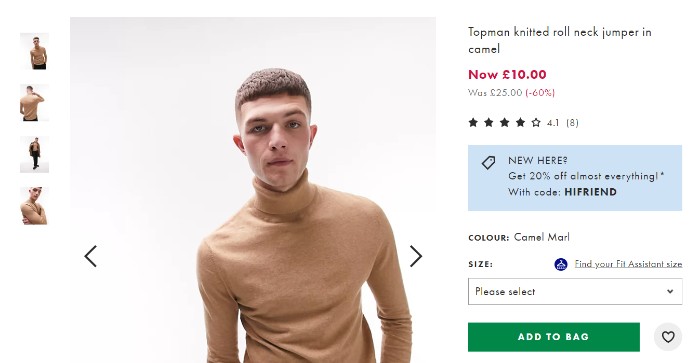 First, you can see the text "Now £10.00," which tells the current price, and under that, you can see the standard offering "Was £25.00". This visually shows the customer what's the price difference.
First, you can see the text "Now £10.00," which tells the current price, and under that, you can see the standard offering "Was £25.00". This visually shows the customer what's the price difference.
The third cue of the sale is the "-60%" sign highlighted in red, which shows you how much the sale really is.
If this wasn't already enough, they have one bonus discount.
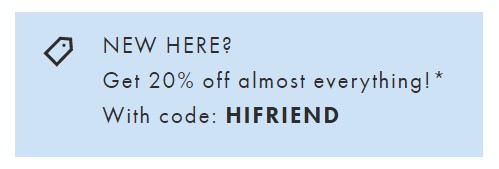 For new customers, ASOS gives a 20% off with a discount code. This is another nice example of how to visually show discounts and encourage customers to check out.
For new customers, ASOS gives a 20% off with a discount code. This is another nice example of how to visually show discounts and encourage customers to check out.
You don't have to have as many discounts as ASOS, but having one that is well done can work wonders.
7. Cost-based pricing
Cost-based pricing includes calculating your product expenses and setting your price accordingly.
Let's look at an example.
Let's say you spend:
- $10 on the production of goods
- $3 on the shipping
- $2 on the packaging
That's a total of $15.
Now that you know your product costs, you should price your products based on them. As a general rule, aim for 2.5 to 3x your product cost so you still have money for advertising and other costs like product storage or rent.
In this case, you would price your product at a price point of $37.5 to $45, which would give you enough margins to cover your other costs like advertising.
If you use cost-based pricing as your pricing strategy, don't forget to factor in your other costs, such as employee salaries and product storage.
There is no replacement for A/B testing
There are multiple ecommerce pricing examples you can choose from.
But at the end of the day, it is A/B testing that will tell you which one works best for your target audience. This means comparing two different variations and seeing which one yields the most conversions.
How do you exactly do that?
You can do it the old way by creating two different versions of your product page and manually tracking the results.
Or you can do it by using a tool like Drip, which comes with proper A/B testing features built-in.
Drip allows you to compare variations of your emails and other marketing materials. It will then show the results in a clear dashboard that helps you determine which ones are the most successful.
Either way, A/B testing is the only surefire way to know which pricing strategy works best for your own audience.
